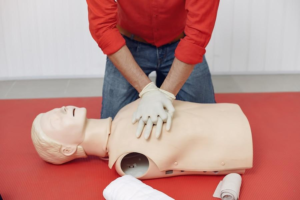
Effective injury treatment requires a holistic approach, from immediate first aid to long-term rehabilitation. This article will explore key techniques for navigating injury treatment, emphasizing the importance of prompt care, professional medical advice, and rehabilitation methods. By adopting this comprehensive approach, individuals can promote smoother recoveries and minimize complications.
Importance Of Injury Treatment
Injury treatment is crucial for promoting healing and preventing further damage. Timely and appropriate care significantly impacts the recovery process, reducing the risk of complications and enhancing healing. Neglecting injuries or improper treatment can lead to chronic pain and limited mobility. Understanding the significance of injury treatment is fundamental for ensuring better and faster recovery outcomes.
First Aid For Common Injuries
Knowing how to administer immediate first aid is vital in the aftermath of an injury, stabilizing the condition and preventing further harm until professional medical assistance is available. Here are key first-aid techniques recommended by Destiny Urgent Cares of Colorado:
- Cuts and Scrapes:Clean the wound with mild soap and water, apply an antiseptic solution, and cover with a sterile bandage. Regularly change the bandage to prevent infection.
- Sprains and Strains (RICE Method):Rest the injured area, apply ice to reduce swelling, use compression bandages for support, and elevate the limb to minimize inflammation.
- Burns:Cool the affected area under running water for at least 10 minutes for severe burns or large areas. Cover with a clean, non-stick dressing, and seek medical attention if severe.
- Fractures:Immobilize the injured limb with a splint or improvised support. Avoid unnecessary movement and seek prompt medical help.
Remember, these first-aid measures are temporary. Seeking professional medical advice is essential to assess the injury’s severity and determine the appropriate treatment plan.
When To Seek Professional Medical Help
Seeking professional medical help is crucial for proper diagnosis and treatment. It complements initial first-aid efforts and ensures effective recovery. Knowing when to seek medical advice can prevent complications and promote healing.
Seek medical help if an injury shows:
- Severe, persistent pain is unrelieved by rest or over-the-counter medication.
- Inability to move or bear weight on a limb.
- Visible deformity or abnormal swelling.
- Loss of consciousness or confusion after a head injury.
- Deep or puncture wounds requiring stitches.
- Injuries from animal bites or rusty objects, potentially needing tetanus shots.
Prompt medical attention helps identify underlying injuries like fractures or dislocations. Healthcare professionals provide specialized treatments, such as wound suturing, bone setting, or medication, to promote healing and minimize complications.
Physical Therapy For Injury Rehabilitation
Injury rehabilitation is essential for recovery, and physical therapy is a cornerstone. Under the guidance of a licensed physical therapist, individuals can restore functionality, strength, and mobility post-injury, reducing the risk of future complications.
Physical therapy entails a personalized treatment plan focused on specific exercises and techniques to enhance range of motion, strength, and flexibility. Therapists may utilize heat or cold therapy, electrical stimulation, or manual techniques to aid healing.
The duration and intensity of therapy depend on injury type and severity, with therapists assessing progress and adjusting treatment plans accordingly. Adherence to prescribed exercises and regular therapy sessions are crucial for optimal outcomes.
Physical therapy facilitates physical recovery, empowering individuals to actively participate in their healing journey while regaining confidence and independence. It equips them with tools to prevent future injuries, promoting long-term well-being.
The Role Of Exercise In Injury Recovery
Exercise plays a crucial role in injury recovery, extending beyond physical therapy. It promotes healing, strengthens muscles and tissues, and prevents muscle atrophy.
Before starting any exercise regimen, consult a healthcare professional or physical therapist for tailored recommendations. Low-impact activities like swimming or cycling are often suggested initially, gradually advancing as healing progresses.
Stretching exercises are vital for flexibility, muscle balance, and joint mobility and reduce re-injury risk. Start gradually and listen to your body, avoiding overexertion to ensure successful rehabilitation.
Mind-Body Techniques For Pain Management
Effective pain management during injury recovery is crucial for overall well-being. Mind-body techniques offer valuable methods for coping with pain, reducing stress, and inducing relaxation.
- Meditation and Deep Breathing: By focusing on breathing and practicing mindfulness, individuals can calm their minds and bodies, alleviating pain and reducing anxiety.
- Guided Imagery: Utilizing mental visualization to create a tranquil environment can alleviate discomfort and foster a positive mindset, promoting healing.
- Progressive Muscle Relaxation: Systematically tensing and relaxing muscle groups help release tension, promote relaxation, and reduce pain and discomfort.
- Acupuncture: This traditional Chinese medicine practice involves inserting thin needles into specific points on the body to alleviate pain and stimulate natural healing mechanisms.
Integrating these mind-body techniques with medical treatment rather than replacing them is essential. Consulting with healthcare professionals or qualified practitioners ensures safe and effective use.
Preventing Future Injuries Through Proper Form And Technique
Preventing injuries through proper form and technique is essential for long-term physical health. To prepare muscles and joints, begin with thorough warm-ups, including dynamic stretching and light cardio. Wear suitable protective gear for high-impact or contact sports to minimize injury risk.
Maintain good posture and body mechanics during daily activities, focusing on lifting with the legs and maintaining a neutral spine to reduce musculoskeletal strain. Gradually increase activity intensity to allow the body to adapt, avoiding sudden spikes that can lead to overuse injuries.
Incorporate cross-training and varied exercises into your routine to prevent muscle imbalances and repetitive strain injuries. Listen to your body, taking breaks when needed, as rest and recovery are essential for overall health and injury prevention.
Conclusion: Taking A Proactive Approach To Injury Treatment And Recovery
Injury treatment is a personalized journey, not a one-size-fits-all process. By recognizing the importance of prompt care, seeking professional help, and committing to rehabilitation strategies, individuals can enhance healing, prevent complications, and reduce the risk of future injuries.
Practical strategies like physical therapy, exercise, nutrition, and mind-body techniques can significantly aid recovery. Individuals can regain health functionality and pursue their passions by taking proactive steps. Prioritize injury treatment, embrace these strategies, and embark on a path to successful recovery.
